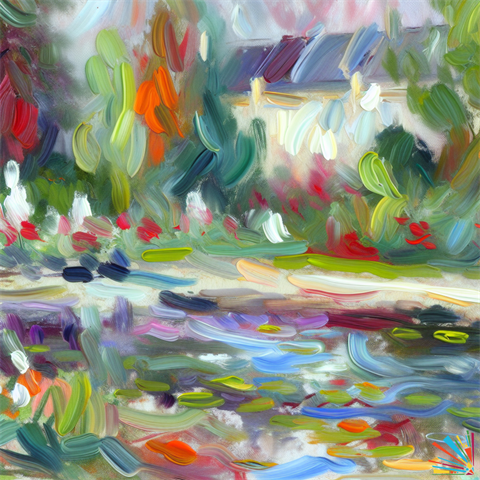Impressionism: Visible Brushstrokes & Light in Outdoor Artistry
Impressionism is a revolutionary painting style that emerged in France in the late 19th century, characterized by a focus on capturing the fleeting effects of light, color, and atmosphere in the natural world. It marked a radical departure from the highly detailed, realistic styles that dominated academic painting, embracing spontaneity and a more subjective view of nature and daily life.
Impressionism broke away from the detailed realism of earlier painting styles, focusing on capturing the ephemeral qualities of light, color, and everyday life. The movement's emphasis on visible brushstrokes, vibrant color, and outdoor painting has had a lasting influence on modern art, paving the way for later styles such as Post-Impressionism and Abstract Expressionism.
Key Characteristics of Impressionism
- Visible Brushstrokes:
- Impressionist paintings often feature loose, short, and visible brushstrokes, which give the artworks a sense of movement and spontaneity.
- Rather than blending brushstrokes for smooth, invisible transitions, Impressionists left them apparent, allowing the viewer’s eye to blend the colors.
- This technique contributed to the paintings’ lively, sketch-like quality, as though capturing a moment in time.
- Focus on Light and Color:
- One of the central goals of Impressionist painters was to capture the effects of natural light and how it changes throughout the day.
- Rather than focusing on precise forms, they studied how light affected color and how shadows were not simply black or grey but filled with reflected hues.
- They often painted outdoors ("en plein air") to directly observe the changing conditions of light, weather, and atmosphere.
- Emphasis on Everyday Scenes:
- Impressionism shifted focus away from historical, religious, and mythological subjects, emphasizing scenes from everyday life.
- Common subjects included landscapes, cityscapes, parks, rivers, leisure activities, cafés, and domestic life.
- This focus on contemporary life allowed Impressionists to explore how modern life and nature interacted, creating snapshots of modernity.
- Bright and Unmixed Colors:
- Impressionists favored a light and vibrant palette, avoiding dark, muted tones.
- They often applied colors in unmixed form directly onto the canvas, letting colors mix optically rather than blending them on the palette.
- This technique gave their paintings a fresh and luminous quality, enhancing the impression of natural light and atmosphere.
- Capturing Momentary Impressions:
- Impressionists aimed to capture fleeting moments—whether the play of sunlight on water, the shifting clouds in the sky, or the movements of people in the streets.
- The word "Impressionism" itself derives from Claude Monet’s painting Impression, Sunrise (1872), which critics initially used mockingly to describe the unfinished, sketchy quality of the style.
- Rejection of Traditional Perspective and Detail:
- While previous styles focused on linear perspective and detailed renderings of form, Impressionists sought a more atmospheric approach.
- They downplayed precise outlines and sharp details in favor of soft edges and diffused forms, prioritizing the overall feeling or "impression" of a scene.
Techniques and Innovations
- Broken Color:
- Rather than blending colors smoothly, Impressionists used "broken" patches of contrasting colors to suggest the play of light and shadow.
- For example, a green tree might have flecks of blue or yellow to reflect the light of the sky or sun.
- Outdoor Painting (En Plein Air):
- To accurately capture the effects of light and atmosphere, Impressionist painters worked outdoors, often creating quick studies in nature that were later refined into finished works.
- This was made possible by advancements like the portable paint tube, which allowed artists to easily bring materials into the open air.
Famous Impressionist Artists
- Claude Monet:
- Often considered the father of Impressionism, Monet’s works focused on landscapes, particularly on how light and weather affected his subjects.
- Famous works: Impression, Sunrise, Water Lilies series, Rouen Cathedral series.
- Pierre-Auguste Renoir:
- Renoir is known for his depictions of people, capturing scenes of leisure and happiness with a vibrant color palette and soft brushstrokes.
- Famous works: Luncheon of the Boating Party, Dance at Le Moulin de la Galette.
- Edgar Degas:
- Though he did not always paint outdoors, Degas was known for his innovative compositions, often focusing on ballet dancers, horse races, and everyday moments.
- Famous works: The Ballet Class, The Dance Foyer at the Opera.
- Camille Pissarro:
- Pissarro’s works captured rural and urban landscapes, using soft brushstrokes and a muted palette.
- Famous works: Boulevard Montmartre, The Harvest.
- Édouard Manet:
- Although not strictly an Impressionist, Manet greatly influenced the movement with his modern subject matter and loose, innovative brushwork.
- Famous works: Olympia, Le Déjeuner sur l’herbe.
- Mary Cassatt:
- An American artist closely associated with the Impressionists, Cassatt focused on intimate scenes of women and children.
- Famous works: The Child’s Bath, Little Girl in a Blue Armchair.
Common Themes in Impressionism
- Nature: Landscapes, seascapes, and gardens were frequent subjects, emphasizing how changing light affected the appearance of the natural world.
- Urban Life: Many Impressionists depicted modern city life, particularly in Paris, showing parks, streets, and cafés filled with people at leisure.
- Leisure Activities: Picnics, boating, dancing, and bathing were common themes, reflecting a growing middle class enjoying newfound leisure time in the modern world.
- The Effects of Weather: Snow, fog, rain, and wind were often explored to show how atmospheric conditions altered the appearance of landscapes.
Notable Works of Impressionism
- Monet: Impression, Sunrise (1872) – The painting that gave the movement its name, capturing the impression of a sunrise over the port of Le Havre.
- Renoir: Luncheon of the Boating Party (1881) – A joyful depiction of friends enjoying a riverside meal.
- Degas: The Ballet Class (1874) – A snapshot of ballerinas in rehearsal, highlighting his fascination with movement and form.
- Monet: Water Lilies series – A famous series of paintings that captures the changing light and reflections on Monet's garden pond.
Classical paintings in Impressionism’s nature-themed style
Impressionism’s nature-themed style is characterized by a deep exploration of light, color, and the ...
Total: 1
Loading...
End

